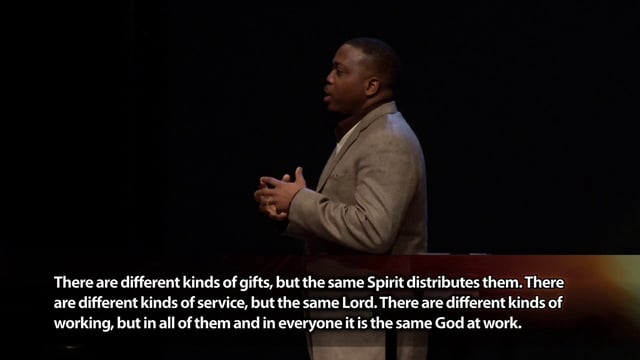Sermon Title: Talented or Spiritually Gifted
Preacher: At the time of recording, Rev. Santes Beatty was the High School Pastor at Kentwood Community Church. Now, Santes works at Wesleyan Church Headquarters in Church Multiplication and Discipleship. As director of multi-ethnic ministry, Santes is helping the Wesleyan Church grow in unity and diversity.
[vimeo id=”88644478″]
Here at Wesleyansermons.com, we think preaching reveals a lot about a pastor’s perspectives. Sermons often reveal a pastor’s views on life, Scripture, culture, and Christ. Through this sermon, Santes reveals some of his paradigms.
Santes Shows Us That:
- Direction is Clear: “We want you to discover, develop, and use your spiritual gifts.” Before coming to the platform, Pastor Santes knew what his sermon should accomplish. After deciding his direction, every element reinforced that trajectory. Each word, illustration, and explanation helps us understand how to discover, develop, and use spiritual gifts. Because of that clarity, we walk away from the sermon with clear steps toward life change. If the preacher doesn’t fully work out where the sermon is heading until standing on the platform, it can feel a little like watching birth take place. It’s painful for the preacher, and uncomfortable for everyone else.
- Uses the Sermon to Shape Culture: Listen to the way Pastor Santes uses the sermon content to shape the culture of KCC. “Consumers ask: ‘How can I maximize what I get, without giving that much?’ Christians think: ‘The leaders of the church exist to equip me so I can serve others. So how can I maximize my time, talents, and treasure to bring unity to the community I’ve been planted in?’” When you come to Kentwood, you don’t just sit in a pew; you stand up to serve.” Though this phrase may sound a little commonplace, it’s memorable and contrasts the culture of most churches. Preaching is a leadership activity and leaders speak to the same sort of culture-shaping values time and time again in memorable ways. If you haven’t found a new way to say something in the pulpit related to one of your church’s values the last two months, it probably isn’t truly a deeply held value.
- Turns a Negative into a Constructive: “When you come to church next time, think about what stuff in the church drives you crazy? That innate ability maybe isn’t to criticize; maybe it’s there to help you come alongside that area to make it grow stronger.” Santes affirms church critics, knowing that their areas of criticism may be their areas of giftedness. Rather than becoming defensive, Santes invites critics’ help. Without them, Santes reminds us, we’d never escape our ruts. In other areas of preaching we can do the same. Doctrinal differences become opportunities to display kingdom unity. Economic downturns are tests of faith. The preacher sees negatives that are destructive in the community and finds ways to jujitsu them toward constructive energy for the community.
- Stories are Integrated with Purpose: Through stories, Santes provides humorous examples of spiritual principles. Santes’ stories build toward his main points: helping us discover, develop, and use our spiritual gifts. A sermonic story done well doesn’t just give a mental break. It provides a mental leap. It helps people cross over a canyon of content effortlessly at the “aha” moment. Jesus says “The father put his ring upon him and his robe, can said “kill the fattened calf for my son who was lost has been found.” At that moment in the story, our minds leap across canyons of content it would have taken paragraphs to explain related to the character of our Father God and the nature of mercy and grace. Stories do that, but only when the intentionally are crafted and directed toward the focused purpose of the sermon.
Application Exercises:
- Plan a Flow: Planning a sermon flow is a little like planning a church vision. As you plan next Sunday’s sermon, create a “main mission.” What should the congregation do as a result of your preaching? Once you determine that, you’re able to harmonize every other quote, story, and word of your sermon towards that trajectory.
- Tell Stories: This coming week, let’s start becoming better storytellers. One of the ways stories are told well, is to tell them before you tell them. One of our mantras in preaching classes is “Never preach in front of people for the first time.” If you need an audience to give a story a practice run, then tell them over lunch or breakfast tables. Call a friend and share it over the phone. As you tell it, make every word count toward the purpose you are building.
- Sprinkle Application: This week, plan a sermon that doesn’t save the application for the end. If all our sermons place application points at the end, the formula becomes predictable. It’s an old Puritan form of preaching that has worked for centuries. But it doesn’t have to be our preaching straight jacket. Mix it up a little; put application points throughout your sermon points, so the congregation can hold onto what God calls them to do after leaving service. Rick Warren often suggests making each point an application point. At the end of the sermon, recap the application, reminding the congregation of their opportunity to respond to God’s prompting.
Sermon review by Dave Ward and Ethan Linder
